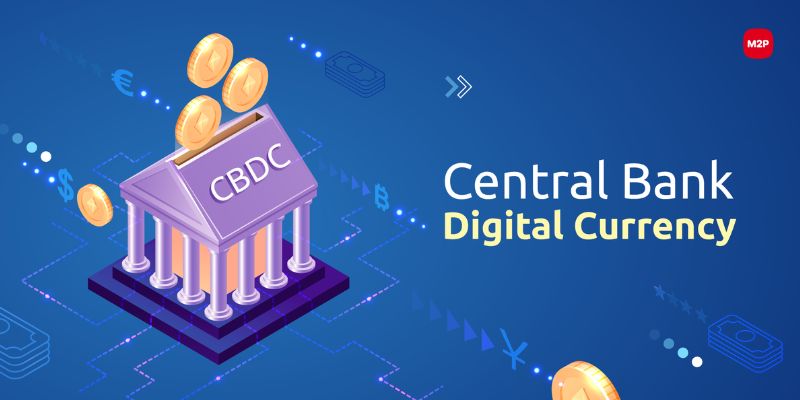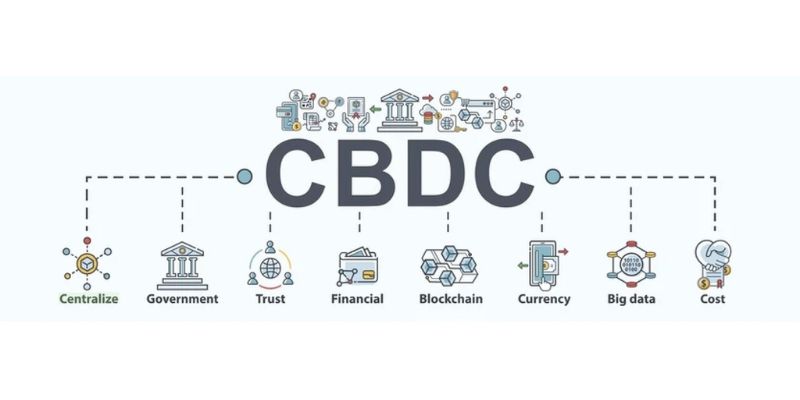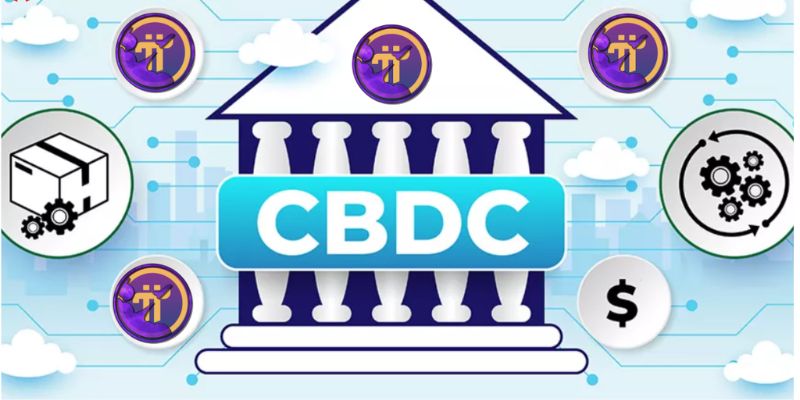Central bank digital currency is shaking up the very foundation of our wallets. Imagine money, not as crumpled bills or worn cards, but as crisp digital code, flowing like electricity through the web of global finance. This isn’t just a future fantasy; it’s a present-day leap we’re all about to take. The rise of CBDCs is not a matter of if, but when. Will you be at the forefront, your digital wallet in hand, as currencies transform beneath our fingertips? Let’s dive into what this means for you, your money, and the world economy. Buckle up—it’s a thrilling ride ahead!
Understanding the Rise of Central Bank Digital Currencies (CBDCs)
The Advent of Digital Fiat Currencies
Money keeps changing. Once, we traded shells. Now, we tap phones to pay. Central Bank Digital Currencies, or CBDCs, are the next step. They are not just ideas. They are real, digital money made by central banks. CBDCs work just like the dollars or euros in your pocket. But they live on phones or cards, not in wallets.
Many ask, “What’s new with digital money?” We’ve had credit cards and online banking for years. Those are just ways to move money – the money itself stays the same. CBDCs are different. They are the money.
Why should you care about CBDCs? They make life better. Think about sending money to friends in seconds, every time. Or buying your favorite snack at the store with a simple tap. No coins, no bills, no wait. And this is just the start.
Comparing CBDCs with Traditional Cryptocurrencies
“Are CBDCs like Bitcoin?” many wonder. They seem similar but are very different. Let’s break it down:
Bitcoin is like a wild, untamed river. It flows on its own, with no one in charge. CBDCs are more like a canal. A central bank guides them, making sure things run smoothly.
The risks of digital currencies often scare people. “Is my money safe?” they ask. With CBDCs, the answer is “Yes, as safe as it can be.” The central bank has your back.
There’s a lot of tech talk around digital money. Words like “blockchain” and “encryption” may sound fancy. But all you need to know is that they help keep your money safe and private.
Still, some worry “Will this digital money see what I buy?” That’s where privacy comes in. Rules and systems are put in place to protect what you do with your CBDCs.
What comes next? More countries are starting their own CBDCs. Some are testing, some are planning. They are learning how to make the best digital money for you.
Digital euros, digital yuan, and digital dollars are all in the works. They are not ready to spend yet, but soon they might be as common as the money we use now.
For CBDCs to reach everyone, countries need to work together. This means making systems that talk to each other. It’s like how you can email friends in other countries. CBDC systems need to do the same.
Getting a CBDC ready is not easy. There’s a lot to think about: laws, tech, and how people will use it.
But the big goal is clear: everyone should get a chance to use this new money, no matter where they live or how much they earn.
CBDCs are more than just a new way to pay. They are a promise for a world where money is fast, safe, and fair for all. So yes, get your digital wallet ready. The revolution is coming, and it looks like a better future for money.

The Technological Foundation of CBDCs
Exploring Blockchain’s Role in CBDC Implementation
Blockchain keeps CBDC safe and allows them to work. It’s like a digital ledger that records every transaction. This ledger is hard to change, which helps stop fraud and double-spending.
When we talk about blockchain and central banking, the tech acts as a strong backbone. It supports the whole digital currency system. Imagine a huge digital book where everything that happens with money is written down. This book is stored across many computers. This way, no single person can control or change the info. This is good for central bank-issued cryptocurrency.
The Significance of Robust CBDC Technology Infrastructure
The tech behind CBDC must be strong, safe, and able to handle lots of activities. Think of it like a big, busy city. A city needs good roads, bridges, and traffic rules so everyone can get around fast and safe. For digital currency by central banks, a strong infrastructure is just as important.
Let’s start by looking at central bank payment systems. These are like the roads and highways for money to move. They need to be able to handle tons of traffic – meaning, lots of money moving around all the time – without any problems.
With good tech, the benefits of CBDC can shine. Faster payments, less cost, and reaching people who don’t have bank accounts are just a start. This is good for everyone. Now, think about CBDC vs cryptocurrency. They may seem alike, but they’re quite different. Let’s not mix them up. One big difference is that CBDC is tied to a country’s official money – like dollars or euros.
Next, let’s chit-chat about digital wallets for CBDC. They need to be easy to use and safe. For both retail purchasers and big business (retail CBDC and wholesale CBDC), a simple tap or click to pay is the goal. Safe digital places to keep our money, that’s what CBDC wallets are.
Now, about the risks of digital currency. Here we’ve got to be careful. There are things like online theft and system crashes to think about. Imagine if someone broke into your piggy bank and stole your saved-up cash. For CBDC, cyber security steps in to protect your digital piggy bank.
For CBDC, making sure everything is above board – following the law – is key. This ties into privacy concerns with CBDC and anti-money laundering CBDC efforts. It’s like playing by the rules to keep the game fair for everyone.
We must lay the groundwork with a great CBDC technology infrastructure. Without it, the whole thing could slow down or even stop, like traffic during a big storm.
Lastly, the CBDC global impact is something to keep an eye on. Countries need to work together so we can use our digital currency even when we travel – that’s called interoperability of CBDCs. But each country also wants to keep a good handle on its money. It’s like having different plugs for electronics in different countries. We have to find a common way to connect.
This is just a bit of how tech plays a huge role in the world of digital money. As we dive deeper into economic implications of CBDC, we see how tech we trust is a must. Want to learn more about how money’s getting a tech update? Stay with me as we explore even more about CBDC.

Advantages and Risks of Embracing CBDCs
Enhanced Financial Inclusion and Real-time Transactions
Imagine money that moves as fast as a text message. This could soon be real with central bank digital currency, or CBDC. What are the benefits of CBDC? Well, CBDC could be a game changer, making money easy to access and send. Even folks without bank accounts could join in. CBDCs are central bank-issued cryptocurrency, but they’re as legit as the cash in your wallet.
With digital currency by central banks, people without a bank could still save and pay with ease. You could pay bills as quick as blinking, saving time and stress. This is huge for places where banks are far or folks have little cash. No more waiting for checks to clear or paying big fees to cash them.
CBDCs promise to cut costs too. They could make banking cheaper by axing some fees we hate. Money could flow all around the world smoother and faster. This means if you’re buying something from far away, you won’t wait ages for the payment to go through.
Addressing Privacy and Cybersecurity Challenges
But hang on, what about keeping money safe? That’s big. CBDC tech has to be solid. What are the risks of digital currency? Bad folks want to steal money or mess with our accounts. So central banks are working hard on cybersecurity in CBDC systems. They’re making sure nobody who shouldn’t see your money can sneak a peek.
Privacy is a hot topic too. How much should the bank know about how you spend your cash? This is tricky. We like our privacy but also don’t want bad guys getting away with dirty money. CBDCs need to find a balance, keeping us safe but not snooping too much.
Talking about risks, if CBDC tech trips up, it could hurt a lot. It might make us unsure about using this new kind of money. Also, if everyone swaps to CBDC all at once, it could shake up banks big time. Some worry this could make things wobble like a bike with one wheel.
In a nutshell, there’s a lot to get excited about with CBDCs. We can look forward to saying goodbye to old bank ways that slow us down. But we can’t rush. Getting CBDC right means thinking hard about how to keep it tight and right. Plus, we have to make rules that fit just right for how we handle our dough online.
Central banks around the world are on it. They’re testing CBDCs in small ways before going big. They know this could jazz up how we deal with money all over the place. It’s not just about making payments zip by fast. It’s about making sure everyone can join in, without fretting over their money’s safety.
So, let’s keep our eyes peeled as this new money era gets rolling. If we nail this, your wallet – or rather, your phone – could be your bank, any place, any time. Think of that next time you’re in line at the bank or waiting for a wire transfer to clear!

CBDCs and the Global Monetary System
Impact on International Trade and Cross-border Transactions
Digital money is changing how we trade across borders. CBDCs, short for central bank digital currencies, are a big deal here. They are like e-money, but central banks issue them. This means they are safe and stable, like the cash in your pocket, but they work online.
CBDCs make sending money to another country easier and faster. With CBDCs, you don’t need to wait days for a payment to clear. This is good for businesses that buy and sell things overseas. They can get their money faster, which helps them grow and make more jobs.
But it’s not just businesses that win. When migrants send money home, every penny counts. CBDCs can make these transfers cheaper, so families get more money.
However, there are some challenges, too. Countries need to work together to make sure these digital currencies can talk to each other. This means building systems that can connect different CBDCs. It’s not easy, but when it works, it can make international trade much smoother.
Preparing for the Future: CBDC Pilot Programs and Policies
Pilot programs are our way to test-drive CBDCs before they hit the road. These programs help us see how CBDCs work in the real world. Think of them like science experiments where we learn by doing.
Several countries are trying out CBDCs right now. They are checking how these digital currencies work for everyday shopping, and also for big business deals. These tests help us make better rules, find and fix problems, and figure out the best ways to keep money safe online.
But we also need good policies. This means setting rules that protect everyone using CBDCs. We look at risks and work out how to deal with them. Like making sure your digital wallet is safe from hackers, and that using digital money is fair for everyone.
We’re also thinking about how CBDCs fit with laws against money laundering. We must make sure CBDCs do not become a tool for the bad guys. So, we design them to track transactions while still respecting privacy.
In all these steps, the goal is to make money work better for you. With CBDCs, we’re building a future where you can pay or get paid instantly, no matter where you or the other person is. As we move ahead with CBDCs, we’re aiming for a global money system that’s secure, fast, and open to everyone.
We dove deep into Central Bank Digital Currencies (CBDCs) and how they are shaping our money’s future. We started by looking at their rise and how they stack up against regular digital money and cryptocurrencies. We also peeled back the layers of tech that make CBDCs tick like blockchain. Plus, we tackled the big perks and the real worries that come with these new digital bucks, including issues like keeping your money safe and private.
CBDCs aren’t just a fad—they’re set to play a huge role in how cash moves around the world and could make buying and selling across borders a breeze. By testing out new policies and programs, countries are gearing up for what’s ahead. To wrap it up, CBDCs are big news for our wallets, and staying informed means we can all be ready for the changes coming our way.
Q&A :
What is a Central Bank Digital Currency (CBDC)?
Central Bank Digital Currency, or CBDC, is a digital form of a country’s national currency that is issued and regulated by the country’s central bank. Unlike decentralized cryptocurrencies, CBDCs are centralized and are considered legal tender. They aim to provide the efficiency and accessibility of digital currencies while remaining under the control and oversight of the nation’s monetary authority.
How does CBDC differ from cryptocurrencies?
CBDCs differ from cryptocurrencies in several key ways. Firstly, CBDCs are issued by a central authority – the country’s central bank – whereas cryptocurrencies typically operate on a decentralized network using blockchain technology. Additionally, CBDCs are legal tender and hold a status equivalent to physical banknotes and coins, whereas most cryptocurrencies are not recognized as legal tender. Lastly, the supply and management of CBDCs are controlled by the issuing central bank, as opposed to the often algorithmically determined supply of many cryptocurrencies.
What are the benefits of implementing a CBDC?
The implementation of a CBDC can offer several advantages, including: enhanced efficiency of payment systems, lower transaction costs, reduced reliance on cash, potential improvements in monetary policy effectiveness, financial inclusion for populations without access to traditional banking services, and increased security and traceability of transactions.
What challenges do central banks face with CBDC?
Central banks face numerous challenges in implementing CBDCs, such as ensuring robust cybersecurity to prevent fraud and hacking, addressing concerns about privacy and data protection, maintaining financial stability, mitigating the risk of bank disintermediation, ensuring interoperability with existing payment systems, and the need for extensive testing to ensure the reliability and scalability of CBDC systems.
How might a CBDC impact the banking system?
CBDCs could impact the banking system in various ways. By providing a direct alternative to bank deposits, they could lead to a shift in how people store and manage their money. This could reduce the funds available to commercial banks for lending, potentially altering the traditional banking model. Furthermore, CBDCs can encourage innovation in financial services, compelling banks to improve their services and offer more competitive rates to retain customers.

